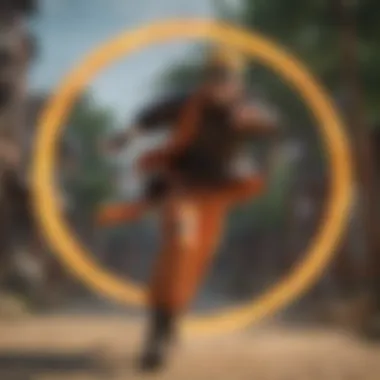An In-Depth Look at the Entire Naruto Manga Series


Intro
The Naruto manga series, created by Masashi Kishimoto, has captured the hearts and minds of millions since its debut in 1999. This iconic series not only chronicles the journey of Naruto Uzumaki, an aspiring ninja, but also delves deep into themes of friendship, ambition, and the struggle for acceptance. While the narrative captivates readers, the underlying messages resonate on a global scale. This exploration aims to provide a detailed overview of the entire Naruto manga set, focusing on character development, thematic richness, and its lasting cultural relevance.
In examining Naruto, one must reflect on its intricate character arcs. Characters like Sasuke Uchiha and Sakura Haruno provide contrasting paths that highlight the complexities of relationships in a high-stakes environment. Through this article, we will analyze the multifaceted interactions among characters and their significance in advancing the storyline. Additionally, we will navigate through pivotal arcs such as the Chunin Exams and the Fourth Great Ninja War, which shape the series' overarching narrative.
Furthermore, we will address the stylistic elements that enhance the storytelling. Kishimoto's art style, character design, and world-building contribute to the immersive experience that Naruto offers. The series also serves as a reflection of Japanese culture, addressing concepts such as honor, perseverance, and the importance of community. Understanding these cultural reflections deepens the appreciation for the work as a whole.
The implications of Naruto extend beyond its pages. The series has influenced a new generation of manga creators and storytellers. By exploring its impact, we can see how it paved the path for contemporary works and genres within the manga and anime space.
Now, let's delve into the Industry Insights that underscore the manga’s role and relevance in the broader comic and anime landscapes.
Industry Insights
Latest Trends in Comic Industry
The comic industry has seen several transformations influenced by digitalization and globalization. Naruto maintains a stronghold as a benchmark for storytelling, inspiring creators to explore deeper narratives and character complexities. As manga gains further traction in Western markets, it competes with webcomics and indie publications.
Behind-the-Scenes of Popular Movies/TV Shows
The adaptations of Naruto, especially the anime, have brought forth a unique phenomenon in pop culture. Behind-the-scenes features reveal the collaborative efforts that go into bringing such a dynamic story to the screen. Voice actors, directors, and animators all contribute to this intricate process.
Impact of Gaming Technology on Pop Culture
The Naruto franchise has expanded significantly in the gaming sector, yielding successful titles such as Naruto: Ultimate Ninja Storm. The interplay between gaming and anime mechanics continues to evolve, pushing boundaries for interactivity and storytelling in gaming.
Emerging Trends in Anime Industry
The rise of digital streaming platforms has revolutionized how anime is consumed globally. With platforms like Crunchyroll and Netflix, Naruto remains a pivotal series that attracts both new fans and seasoned enthusiasts, reflecting the ongoing growth in global anime consumption.
In essence, understanding these industry insights offers a contextual framework for appreciating Naruto’s position in the annals of manga history. Next, we shift our focus to Reviews & Recommendations, where we will evaluate comic book series and suggest must-watch recommendations.
Preamble to Naruto
Naruto is not just a manga; it is a global phenomenon that has significantly influenced both anime and the manga industry. Its intricate character arcs and profound themes resonate deeply with audiences worldwide. For this reason, understanding the fundamentals of Naruto is crucial for anyone interested in comic culture, storytelling, or the evolution of modern entertainment.
The series, created by Masashi Kishimoto, combines personal growth, friendship, and the struggle for acceptance. Its compelling narrative engages readers, making them reflect on larger social issues. Observing Naruto’s life journey allows fans to explore their own experiences and aspirations, thus enhancing the overall impact of the story.
In this section, we will delve into the genesis of Naruto, examining its origins and how it came to be a staple in manga culture. Next, we shall explore how the manga industry itself evolved, partly as a result of Naruto's success. The interplay between these factors shapes the surrounding pop culture that includes comics, movies, TV, anime, and gaming.
The Genesis of Naruto
Naruto first appeared in Shueisha’s Weekly Shonen Jump magazine in 1999, quickly captivating a robust audience. Before this, Masashi Kishimoto had faced several challenges, including failed drafts and concepts for other series. However, his determination led to the creation of Naruto Uzumaki, a loud and brash ninja longing for acknowledgment from those around him.
The character of Naruto is a reflection of Kishimoto's own feelings of loneliness and desire for recognition during his childhood.
- Stemming from these personal experiences, Kishimoto crafted a story about overcoming adversity and forming bonds.
- The protagonist navigates a world filled with conflict, which resonates with anyone who has faced challenges in life.
- Ultimately, this authentic emotional connection spawned a narrative that blended humor, action, and depth, contributing to its appeal.
As Kishimoto developed the plot, he focused on themes that highlighted not just personal growth, but also the cultural significance of camaraderie and rivalry. This approach laid a foundation for Naruto's lasting popularity and its critical role in shaping the manga landscape.
The Evolution of the Manga Industry
The late 1990s marked a significant turning point for the manga industry. During this period, the rise of serialization in magazines, alongside the advent of anime adaptations, changed how stories were consumed. Naruto's success epitomizes this shift, demonstrating how a manga could achieve massive popularity and subsequently influence television adaptations.


Several factors contributed to this evolution:
- Increased accessibility: Digital platforms began to emerge, allowing readers to access manga through various channels.
- International reach: Translations facilitated the global spread of manga, fostering a diverse fanbase.
- Merchandising and spin-offs: Brands began to create an extensive range of products and adaptations, broadening audience appeal.
As Naruto rose in popularity, it spurred new interest in shonen manga, paving the way for future works. Its narrative depth and character-driven stories inspired other creators. The reverberations of Naruto's influence continue to be felt in the current manga landscape, showcasing its integral role in the history of this art form.
"Understanding Naruto is essential not just for appreciating the work itself but also for recognizing its broader cultural significance."
Overview of the Whole Naruto Manga Set
The Naruto manga series holds a central position in contemporary manga culture. It is not just a story about ninjas; it is a rich tapestry of themes, character arcs, and intricate world-building that resonates with audiences around the world. Understanding its structure and publication history is essential for appreciating the series' impact and success. This section will provide insights into the major components that define the Naruto experience, laying the groundwork for a deeper analysis to follow.
Structure of the Series
The narrative structure of Naruto is meticulously crafted. Spread over 700 chapters, the manga is divided into two parts: Naruto and Naruto: Shippuden. The initial arc introduces us to Naruto Uzumaki, a young ninja with dreams of becoming Hokage, the leader of his village. This part sets the stage for themes of friendship and rivalry, focusing on his relationships with Sasuke Uchiha and Sakura Haruno.
In Naruto: Shippuden, the story shifts in tone and complexity. The characters have matured, and the stakes are higher. The arcs delve deeper into themes of identity, legacy, and the impact of war. This division enhances the reader's engagement as they witness characters grow and evolve over time.
Key characteristics of the series' structure include:
- Character Development: Evolves throughout both parts.
- Interwoven Story Arcs: Each arc builds on previous events, creating a cohesive narrative.
- Themes Revisited: The series revisits its core themes, making them more profound in Shippuden.
Narrative Themes
The narrative themes in Naruto serve as a foundation for its storytelling, enriching the reader's experience. Themes like friendship, self-discovery, and the quest for legacy resonate throughout the series, providing significant insight into characters’ motivations and development. Understanding these themes is crucial for appreciating the complexities of the plot and the character interactions that define the series.
Friendship and Rivalry
Friendship and rivalry are two core themes intertwined in Naruto. The bond between characters like Naruto Uzumaki and Sasuke Uchiha illustrates this duality effectively. Naruto's unwavering commitment to his friends contrasts sharply with Sasuke’s initial focus on vengeance. This tension forms the basis for many pivotal moments within the series.
- Character Dynamics: The relationships in Naruto show how friendships can evolve and strengthen under pressure. Naruto’s desire to bring Sasuke back from darkness highlights the strength of bonds formed through shared experiences.
- Impact on Growth: Rivalries, especially between Naruto and Sasuke, drive character growth. Each character's journey is influenced by their connection with one another. This theme emphasizes that motivations can be both constructive and destructive.
The Journey of Self-Discovery
The journey of self-discovery is another major theme that permeates the Naruto series. Many characters undergo significant transformations, searching for their own identities. Naruto’s growth from an outcast to a hero is emblematic of this journey.
- Challenges and Triumphs: Throughout the series, characters confront their insecurities. Naruto’s struggles to gain acceptance reflect the broader human condition of seeking belonging in society. Each challenge leads to personal growth, emphasizing resilience.
- Identity Exploration: The series explores how identity is shaped by relationships and choices. The diverse cast, from Naruto to Sakura Haruno, showcases varied paths to self-discovery, making the theme relatable and engaging for readers.
Legacy and Heritage
Legacy and heritage are significant themes that tie the story's temporal layers together. Many characters grapple with their family histories, impacting their actions and decisions.
- Influence of Ancestry: Characters like Sasuke are driven by the weight of family legacy. His connection to the Uchiha clan’s history intensifies his quest for revenge, illustrating how heritage can shape one’s path.
- Passing the Torch: The concept of legacy manifests in the mentorship dynamics presented in the manga. Characters like Kakashi Hatake guide the next generation, emphasizing the importance of wisdom passed down from one generation to the next.
"In Naruto, the intertwining themes of friendship, self-discovery, and legacy create a rich tapestry that captivates audiences around the world."
These narrative themes create depth and offer a greater understanding of the characters and their motivations, contributing to Naruto's lasting impact on both fans of manga and the broader cultural landscape.
Character Analysis
Character analysis is fundamental to understanding the intricate layers of the Naruto series. Each character functions not only as a protagonist or antagonist but also embodies broader themes and values that resonate with audiences. This analysis provides insight into narrative structure and emotional depth, showcasing how relationships and personal growth drive the story forward. Through careful examination of individual journeys, readers gain an appreciation for characterization as a rich tapestry, rather than a mere list of traits.
Naruto Uzumaki: From Outcast to Hero
Naruto Uzumaki's journey is central to the series, transforming from a misunderstood outcast to a celebrated hero. Initially, Naruto faces alienation due to his status as a jinchuriki, a host for the Nine-Tails beast responsible for great destruction. This early isolation shapes his character, fueling his desire for acceptance and recognition.


His determination is matched by his innate optimism and resilience. Throughout the series, he demonstrates growth through challenges, forming bonds with others and showing unwavering resolve. This change reflects a remarkable evolution, making his eventual acceptance in the village not just a personal victory but a reflection of his impact on others.
Sasuke Uchiha: The Complexity of Revenge
Sasuke Uchiha's character offers a contrast to Naruto, emphasizing themes of revenge and redemption. Following the massacre of his clan by his brother Itachi, Sasuke becomes consumed by a singular desire for vengeance. This obsession leads him down a dark path, showcasing the consequences of harboring hatred.
Yet, Sasuke’s narrative is not solely defined by his quest for revenge. His journey illustrates the struggle between personal despair and the possibility of forgiveness. In the end, his return to the village highlights a significant shift from vengeance to collaboration, representing a complex but necessary evolution in his character arc.
Sakura Haruno: Growth and Empowerment
Sakura Haruno serves as a pivotal character, illustrating significant growth throughout the series. Initially portrayed as dependent on others, her journey is one of self-discovery and empowerment. With guidance from Tsunade, she evolves from a character primarily defined by her infatuation with Sasuke to a formidable kunoichi in her own right.
Sakura's development emphasizes the importance of strength and resilience as a woman in a male-dominated world. She confronts her insecurities and learns to harness her own skills, proving that individuality and self-reliance are invaluable. Her evolution from a passive role to an assertive and skilled ninja serves as a crucial component of her character analysis.
Supporting Characters and Their Roles
The richness of Naruto's world is further enhanced by its supporting characters. Characters such as Kakashi Hatake, Hinata Hyuga, and Gaara play vital roles in developing the main cast and themes. Each character embodies unique values and perspectives, enriching the narrative.
Kakashi serves as a mentor, embodying the complexity of leadership and expectation. Hinata represents quiet determination and the struggle with self-worth. Gaara's transformation from a lonely host to a leader showcases the significant theme of overcoming one’s past.
Supporting characters also facilitate growth for Naruto, Sasuke, and Sakura, reinforcing the idea that one's journey is shaped through relationships. Each character's contribution shapes the series' overarching themes of connection, making the narrative more compelling.
"In the end, Naruto's world is a reflection of individual struggles that culminate in shared journeys, highlighting the interdependence of every character's growth."
Each of these segments ties back to the central themes of Naruto, allowing readers to engage thoughtfully with the material, and appreciate the profound character dynamics that make this manga series a lasting cultural phenomenon.
Artistic Elements
Artistry in manga is not merely an afterthought; it serves as the backbone of storytelling, character portrayal, and theme exploration. In Naruto, the artistic style is intricately tied to its narrative and reflects the emotional states of characters and the gravity of the plot. The visual aspect captivates readers, inviting them into a world where each panel is filled with action, emotion, and detail.
Important aspects of artistic elements include:
- Character Design: Each character in Naruto has a unique design that not only reflects their personality traits but also denotes their growth and evolution throughout the series.
- Background Art: The settings are richly detailed and contribute to the world-building, allowing readers to immerse themselves in the Hidden Leaf Village and beyond.
- Action Sequences: The dynamic illustration of battles in Naruto captures the thrill and intensity of ninja combat, making readers feel the stakes involved.
The Naruto manga is a testament to how graphics amplify narrative depth, and its artistry plays a vital role in communicating complex themes and emotions.
Visual Style and Artwork
The visual style of Naruto is distinctive and noticeably fluid. Masashi Kishimoto's artwork significantly shapes how the story is perceived. The lines are often bold and expressive, which complements the action-driven sequences.
With a careful balance between detailed backgrounds and character expressions, the artwork guides the reader's emotions. Key components include:
- Character Expressions: Kishimoto effectively utilizes the characters' facial expressions and body language to convey emotions, recently adding layers to the dialogues.
- Panel Composition: The arrangement of panels varies, with some pages featuring large, striking images that pull the reader into the moment. Conversely, smaller panels are used for dialogues, creating a rhythmic flow.
Each chapter is a visual journey that enhances the readers' connection to the plot.
Symbolism and Iconography
Symbolism in Naruto is rich and multifaceted. Many elements within the story have deeper meanings that enhance the viewer's understanding of themes and characters. For instance, the sharingan eye of the Uchiha clan serves far beyond its physical manifestation. It symbolizes wisdom, trauma, and the heavy burden of carrying a legacy.
Key symbols include:
- Ninja Tools: From shurikens to kunai, every tool holds practical and symbolic meaning, representing the ability and growth of the characters.
- Bijuus: These beasts symbolize the primal forces of nature and the struggle against one's inner demons.
Through symbols, Naruto effectively communicates profound concepts like heritage, conflict, and reconciliation, adding depth to the reading experience.


In summary, the artistic elements in Naruto play a crucial role in shaping its narrative and thematic depth. The visual style complements the storytelling, while symbolism enhances the overall understanding of the series. It is this intricate blend that keeps readers engaged and invested in the journey of its characters.
Cultural Impact
Cultural impact is a crucial aspect when examining the Naruto manga series. The far-reaching effects of the story extend beyond simple entertainment, making it a significant phenomenon in both Japanese and global pop culture. By analyzing Naruto's cultural significance, readers can appreciate how it reshaped narrative styles, influenced character development, and fostered new conversations about identity and societal values.
Influence on Japanese Pop Culture
Naruto has indelibly marked Japanese pop culture. It set trends in storytelling and character archetypes. The series introduced complex themes such as perseverance and the struggle against societal norms. Many other manga and anime followed its lead in exploring deeper emotional and social issues.
- The character designs from Naruto, especially those of Naruto Uzumaki and Sasuke Uchiha, have become iconic.
- Various merchandise, from action figures to clothing, emerged, solidifying its place in various segments of youth culture.
- Events like cosplay conventions frequently see fans dressed as Naruto characters, showcasing the series’ influence on contemporary fashion and youth expression.
In pizza parlors and gaming cafes, you may spot murals depicting Naruto's journey. Such artistry reflects admiration and the profound cultural resonance the series holds in Japan. Its terminology and catchphrases have even slipped into colloquial language, making it part of everyday conversation among fans.
Global Reach and Adaptations
Worldwide, Naruto stands as a testament to the globalization of manga. Its translation into multiple languages facilitated a massive international fanbase. This process introduced diverse cultures to Japanese storytelling, effectively bridging cultural gaps.
- Adaptations, including animated series, films, and video games, helped elevate the brand and expand its audience.
- The series has spawned numerous spin-offs and adaptations, including the sequel series, Boruto: Naruto Next Generations.
- Collaborations with games such as Fortnite and mobile apps created avenues for interacting with its universe, drawing in diverse groups from outside traditional anime fans.
This extensive global reach emphasizes Naruto's role not merely as a series, but as a lasting cultural artifact that touches on universal themes of friendship, perseverance, and identity.
Critical Reception
Critical reception is a fundamental aspect of understanding the impact and legacy of the Naruto manga series. It reflects how critics and audiences interpret and evaluate the story, characters, and artistic choices made by the creator, Masashi Kishimoto. A deep analysis of critical reception showcases not just the quality of the work itself but also its cultural significance and influence within the wider manga industry. This section will delve into key reviews, highlight critical perspectives, and explore the long-term legacy of Naruto in both the fan community and the broader cultural landscape.
Review Highlights
Critics have overwhelmingly applauded Naruto for its compelling narrative and character development.
- Character Growth: The evolution of Naruto Uzumaki and Sasuke Uchiha has been particularly praised. Reviewers note how these characters undergo significant transformation, representing the complexity of personal growth and relationships.
- Story Arcs: Key story arcs, such as the Chunin Exam and the Pain's Assault arcs, have received attention for their emotional weight and intricate plotting. These narratives often introduce moral dilemmas that resonate deeply with readers.
- Art Style: Kishimoto’s art style, characterized by dynamic action sequences and expressive character designs, has also been highlighted. Critics commend the consistency and creativity throughout the series.
“Naruto captures the essence of storytelling by weaving together individual, relational, and societal challenges.”
- Impact on Manga Industry: The series is considered a turning point in the manga industry. Its commercial success established benchmarks for marketing and publishing future manga.
- Themes: Reviewers frequently recognize the series’ exploration of themes like friendship, rivalry, and redemption as central to its appeal. These themes transcend cultural barriers, allowing Naruto to connect with a global audience.
Fan Reception and Legacy
The fan reception of Naruto is as multifaceted as the series itself. Many fans view it as a pivotal work that defined a generation of manga readers.
- Cult Following: Since its debut, Naruto has cultivated a loyal fanbase, resulting in a robust community dedicated to discussing, analyzing, and celebrating its rich universe.
- Cosplay and Fan Art: The influence of Naruto extends beyond the pages of the manga. Cosplay culture and fan art have flourished, demonstrating the series' compelling character designs and storylines. Many conventions feature Naruto prominently, showcasing fan interpretations and tributes.
- Enduring Legacy: Over the years, the series has spawned numerous adaptations, including anime, films, and video games, contributing to its lasting presence in modern pop culture. These adaptations have kept the narrative alive and introduced it to new generations of fans.
- Crossover Appeal: The themes present in Naruto have found resonance in other media, being referenced in various works. Video games and anime frequently cite Naruto as an influence, perpetuating its relevance.
Overall, the critical and fan reception of Naruto combines to form an intricate tapestry that highlights its importance not only as a manga but also as a cultural phenomenon that continues to impact the world of anime and storytelling.
Culmination
In this article, we conclude with an examination of the profound impact that Naruto has had, not only on individuals but also on the manga industry as a whole. This is not merely an analysis of a popular series; it's an exploration of how Naruto reflects evolving narratives and cultural contexts in Japan and beyond.
The Lasting Legacy of Naruto
The legacy of Naruto is multifaceted, reaching into both pop culture and societal themes. The story's core messages of perseverance, friendship, and self-acceptance resonate strongly with readers. This appeal contributes to the series' enduring status. It holds a significant place in global entertainment, as it continues to influence countless creators and writers.
One of the astonishing aspects of Naruto is its ability to engage diverse audiences. Naruto successfully crosses generational lines and has captivated readers from various backgrounds. Several fans have shared personal stories of how the series has inspired their journeys, reinforcing the notion that it is more than just an adventure; it serves as a powerful source of motivation.
Naruto also has made its mark through various adaptations. The character’s popularity has surged with the release of anime adaptations, movies, and spin-off series like Boruto: Naruto Next Generations. This has helped to keep the story alive in contemporary culture, invigorating discussions about its themes and characters, and leading to a sustained fan engagement.
Future Perspectives in Manga
As we look ahead, the influence of Naruto on the manga medium is undeniable. The themes and character dynamics introduced in Naruto have set a new standard for storytelling in manga. The blend of personal struggle and broader societal issues encourages contemporary manga creators to explore deeper themes, thereby enriching the storytelling landscape.
Moreover, the trend toward diversity in character representation and narrative structure is growing. New works continue to emerge that reflect these evolved sensibilities. The success of Naruto has paved the way for more manga series that embrace complex characters and narratives.



